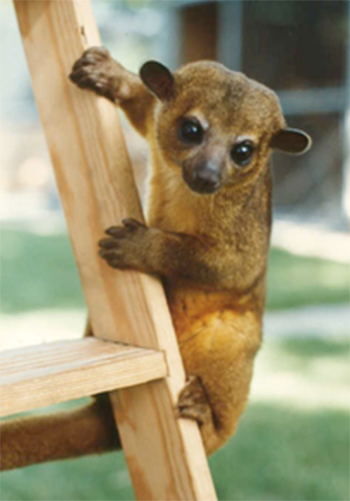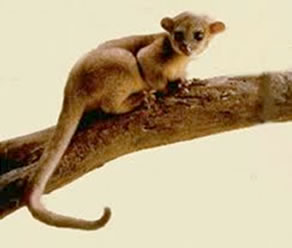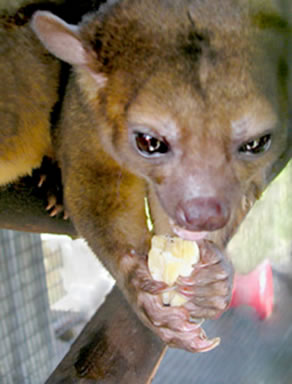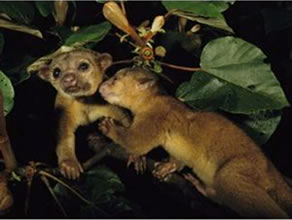The Kinkajou
Potos flavus

Taxonomy :
Kingdom Animalia
Phylum Chordata
Class Mammalia
Order Carnivora
Family Procyonidae
Quick Facts
Animal Type: Mammal
Diet: Omnivore
Average size: Head and Body 17-22 Inches, Tail 16-22 Inches
Weight: Four to seven pounds (two to three kilograms)
Life span: 20 to 25 years, although one at the Belize Zoo lived 39 years
Gestation: 112 to 118 days
Number of young at birth: One to two
Weight at birth: Two ounces (55 grams)
Age of maturity: 18 to 20 months
Life History and Ecology
Kinkajous (Potos flavus) are nocturnal mammals native to the lowland rainforests of Central and South America. Their habitats range from eastern and southern Mexico through Belize and Costa Rica in Central America and down as far south as Ecuador and southern Brazil in South America. This animal’s love of honey along with its honey colored fur has given it the nickname the “Honey Bear” (Anonymous 2003).
 Physical Characteristics/Behavior
Physical Characteristics/Behavior
The kinkajou belongs to the raccoon family and is directly related to the red panda that lives in China, the olingo, the civet and cacomistle, which are considered New World residents. Kinkajous have a rounded head, small ears, sharp teeth, a long body and soft thick brown fur. They are often referred to as a honey bear because of the yellowish brown color of its fur, but in Belize it is known as the “ night walker.” The kinkajou has a long tail that helps to balance the animal and it is also used as a fifth hand so to speak to help in climbing. This animal also has a five-inch long tongue, which is used in reaching nectar and honey that otherwise may be out of reach. Kinkajous have an excellent sense of touch and smell, but very poor vision. They cannot see color; they cannot sense differences in colors. With this poor vision the kinkajous rely heavily on their keen sense of touch and smell to avoid predation. As for communicating with each other the animals communicate by scent marking around where their homes are located and along where they travel. There are several scent glands located on their face, mouth, throat and abdomen. They also do vocal calling ranging from soft chirps to shrill screams (Myer).
Kinkajous are nocturnal animals meaning that they are primarily active at night and they are arboreal (tree dwelling). There peak activity is between 7 p.m. until midnight and then again about an hour before dawn. During the day they sleep in the tree hollows or somewhere in the shade to avoid the sunlight. Since the kinkajous are tree dwelling animals they usually live in the canopies of the rainforests and rarely if ever come down to the jungle floor. Kinkajous live in the warm humid rainforests of Central and South America where the temperatures range from the upper 70s to 100 degrees. They usually live at high elevations not exceeding 2200 meters (Myer).
 Diet
Diet
Kinkajous have a set of 36 sharp teeth, which give them the impression of being carnivores. However, they are primarily frugivorous (fruit-eaters), eating on fruit most of the time. Their basic diet includes but is not limited too: figs, grapes, bananas, melons, apples and mangos. To stay hydrated kinkajous drink water that has collected in tree notches and on leaves, but the fruit that they eat is their most important source of water. When they eat they will purposely hang upside down or on their backs to keep from losing any of the juice. Since the fruits that are common in the kinkajous diet are seasonal they will also eat frogs, insects, honey and bird eggs.
The Kinkajous play a very important role to the ecology of the tropical rainforests. They are important pollinators and seed dispersers an important role that is not filled by any other carnivore. For example, when a kinkajou feeds, pollen adheres to its face and it is then deposited on other plants as the animal moves throughout the treetops (Myer).
 Reproduction
Reproduction
The kinkajou becomes sexually mature between 18 and 20 months. Males reach maturity at about 1.5 years and females at 2.5 years. The female is in heat about every three months. Out in their natural habitat the kinkajous usually avoid each other except when mating. The female kinkajou will give birth to only one or two cubs per year. The gestation period ranges from three to four months and usually only one cub is born at a time. Births in the wild usually occur between April and December. The cubs are born with their eyes and ears shut. Within two to six weeks after birth they will open and in about another three to six weeks the tail becomes prehensile. The mother kinkajou is very protective of her offspring. She will carry the infant upside down below her chest to protect it from any danger (Anonymous).
Lifespan and Current Status
Kinkajous live approximately 20 to 25 years. Their main predators in the wild include the tayra, fox, jaguarundi, jaguar, ocelot and humans. They are often hunted for their meat and fur. The kinkajou is not currently on the endangered species list, however their status in the wild is threatened. Deforestation and fur hunting have taken a significant toll on the current population of kinkajous (Anonymous).
Personal Interest
One of the main reasons that kinkajous interest me is that many people keep them as pets. Although it is not recommended to do many wildlife lovers keep them as pets because they are very playful and friendly except when they are just getting up from a nap. I have looked into buying a kinkajou for myself, but it does get quite expensive since you have to buy their food and a cage for them. Another fact that interests me about these animals is that there is still some mystery surrounding how they live in the wild regarding their social structure. I would like to be able to look more into their social lives and see if they prefer to live in groups or if they truly do live solitary in the canopies in the rainforests.
Recent Research
Most research that has been done in recent years has to do with feeding behavior, food preferences and social behaviors of the kinkajous. Ronald Kays a zoologist from the New York State Museum has been doing research in Panama. Kay’s research that was partly funded by the National Geographic Society shows that kinkajous here live almost entirely on fruit, especially wild figs. They lap supplemental balsa-flower nectar with a long tongue. "Ecologically, they aren't carnivores," he says. Using DNA and radio tracking — and following the kinks for neck-craning hours with flashlight and binoculars — Kays discovered an unusual social structure. A female, two males, a sub adult and a juvenile typically make up a family, sleeping together and grooming one another, but usually foraging separately. Unlike most mammals, it's the female that leaves home when sexually mature, at about 2.5 years. The turf passes from father to sons, and males develop stronger bonds than females. "Once I saw a father and young male playing in a fig tree," says Kays. "They were hanging by their tails and boxing each other in the head (Menino, 2003)." Kays also did a study in which he studied kinkajou feces to observe what it ate most. It was found that the diet of the kinkajou (Potos flavus) described from analyses of feces and observations of habituated individuals was primarily ripe fruit food comprising 90.6% of feeding bouts and present in 99% of feces. Leaves and flowers made up less than 10% of the diet. No animal prey was eaten. Seventy-eight species of fruit from 29 families were detected. Moraceae was the main plant family in the diet and Ficus was the most important plant genus. Kinkajous preferentially fed in large fruit patches. Selection indices were calculated for 37 fruit species. Compared with other large mammalian frugivores in central Panama the diet of kinkajous is most similar to the spider monkey (Kays, 589).
As for the research into the social behavior of the kinkajous John L. Glittleman along with Ronald Kays researched the social organization of the kinkajous. They suggested that, “ The social organization of this species is more complex then previously reported, involving greater inter-individual interactions: this perhaps is more consistent with the kinkajous morphological and ecological traits which resemble primates (Glittleman and Kays 530).”
Summary of the Research
The most research being done over kinkajous is basically trying to disprove that kinkajous live in solitary unless they are mating and that they are true carnivores. By scientific definition the kinkajou is a carnivore based on its sharp teeth, but it has been proven by research that they eat mostly fruits and rarely eat anything else unless fruits are not available. As for their social interactions research is still being done, but it is becoming more and more apparent that the kinkajous might actually interact with one another such as primates do.
References
Please note that the following references may have either been removed or relocated by the webpage owners since the time this student report was created.
Anonymous. "Kinkajous, Kinkajou Pictures, Kinkajou Facts – National Geographic." Animals, Animal Pictures, Wild Animal Facts - National Geographic. Web. 26 May 2011.< http://animals.nationalgeographic.com/animals/mammals/kinkajou/>.
Anonymous. "Kinkajous", National Geographic Magazine (October 2003), http://magma.nationalgeographic.com/ngm/0310/feature2/index.html
Anonymous. "San Diego Zoo's Animal Bytes: Kinkajou." Welcome to the San Diego Zoo. Web. 26 May 2011. <http://www.sandiegozoo.org/animalbytes/t-kinkajou.html>.
Kays, R.W. (1999). Food preferences of kinkajous (potos flavus): a frugivorous carnivore. Journal of Mammalogy, 80(2), 598-599.
Stable URL: http://www.jstor.org/stable/1383303
Kays, R.W., & Gittleman, J.L. (1995). Home range size and social behavior of kinkajous (potos flavus) in the republic of panama. The Association for Tropical Biology and Conservation, 27(4), 530-534.
Stable URL: http://www.jstor.org/stable/2388969
Menino, H. (2003, October). The kinkajou. National Geographic Magazine, 204(4),
Myer, Dan. "Osito the Kinkajou." Blue-n-gold.com. Web. 24 May 2011. <http://www.blue-n-gold.com/halfdan/osito.htm>.
External Links
http://www.blue-n-gold.com/halfdan/osito.htm
http://animals.nationalgeographic.com/animals/mammals/kinkajou/
http://www.sandiegozoo.org/animalbytes/t-kinkajou.html